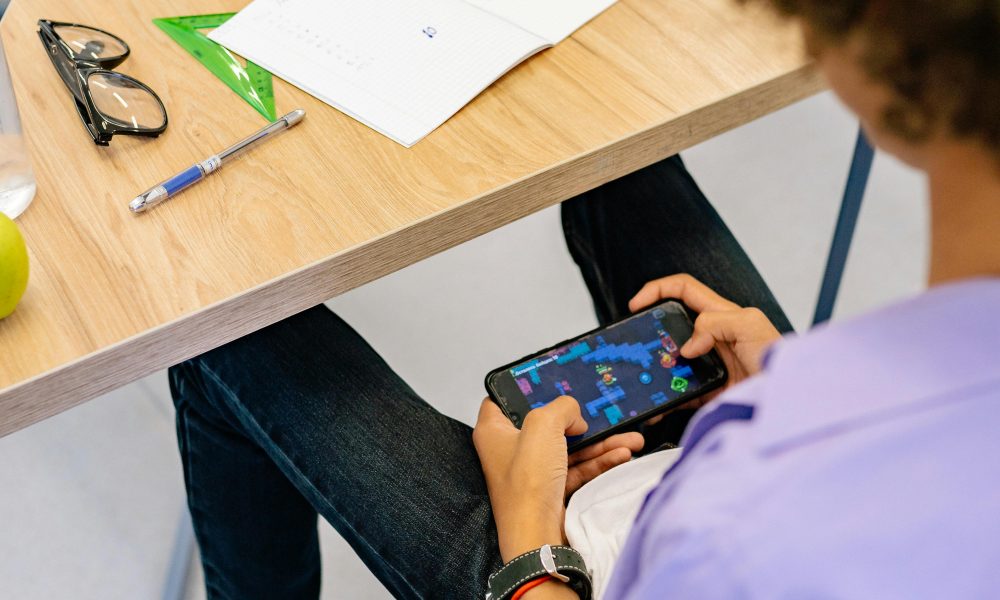Incorporate, Don’t Ban: How Schools Can Embrace Phones as Educational Tools
According to AP News, “77% of US schools say they prohibit cellphones at school for non-academic use.” However, a study from Common Sense Media stated that “97% of kids use their phones during school hours, and that kids say school cellphone policies vary — often from one classroom to another — and aren’t always enforced.” I could say the same for myself since my school enforces a rule of “no phones in the hallways or during class,” but this isn’t followed every day, and it really depends on what teacher you have and if their classroom phone policy is more relaxed or not. This goes to show that although there are policies on phone use in school, numerous schools actually fail to properly implement them, leaving there only to be discord on whether or not phone bans in school are truly necessary.
Since the first release of the iPhone in 2007, the rise and use of advanced technology has skyrocketed. Now, over 86% of the global population own a smartphone, with 97% of teens in the U.S. (from ages 15-17) having access to a phone. Despite the advancement in technology and smartphones being beneficial towards the social and economic development of society, it is also shown that the overuse of phones can be detrimental to the mental health of many, especially teenagers. The solution to all this looks to be prohibiting the use of phones during teens’ learning time in school. Yet, when doing this, most schools still tackle issues with teens continuing to use them, so while I believe it is necessary to limit phone use in school, the way that school administrators and staff are going about it is just not working. Cell phones should be allowed in schools, but only to a certain extent, and schools should teach their students to manage their technology usage in a healthy manner.
Schools such as Maryland High, which is where teacher Patrick Truman teaches, forbid phone use in class but have always struggled to actually execute these bans properly. Truman shares, “Cellphone use is out of control. By that, I mean that I cannot control it, even in my own classroom.” To try and handle this issue, Truman purchased a 36-slot caddy for storing student phones. Unfortunately, his money had gone to waste, as students continued to hide their devices in laps and under books which did nothing but worsen the situation. “Tired of being the phone police, he has come to a reluctant conclusion: ‘Students who are on their phones are at least quiet. They are not a behavior issue.’” These words iterate that despite there being a school-wide ban on phones, at the end of the day, it is the teachers who are in charge of administering them, which didn’t go too well for Truman. That leaves teachers like Truman to end up becoming more lenient with phones as they have exhausted all their resources.
For that reason, Christine Elgersma, the senior editor for social media and learning resources at Common Sense Media thinks, “Being vehemently anti-cellphone may backfire . . . Allowing kids to use the devices for classwork is a way to acknowledge that these are really cool tools, and that some of what kids are doing on their phones is really impressive and creative and important to them.” Elgersma encourages us to not “discount how woven into the fabric of their lives these devices are.” These statements really resonate with me, due to the fact that phones, when used for educational purposes in the classroom, can be much more of a help to teachers than you might think. One example of this can be seen in fifth-grade humanities teacher Stevie Frank’s classroom, where she sets up stations around the room with passages that her students read and answer questions on. Afterward, the student can scan a QR code and watch a video of Frank explaining the answer. Additionally in high school science teacher Kristin Daley Conti’s classroom, students use their phones to capture photos of plants, insects, squirrels, and more that are a part of the biodiverse ecosystem near their school. They can then share them in a digital journal that can also be accessed by parents. Daley Conti went on to give some advice to teachers who are considering incorporating phones into their curriculum; “Listen to kids’ ideas. Ask them questions like, ‘Do you think we’re using our phones too much?’ or ‘Could we use our phones in class responsibly?’”
Some school staff and teachers remark that if students can use their phones during school, most teens won’t be able to stay concentrated and will lean towards abusing that power, which can be true. Even so, teacher Frank’s response to this is one that I highly agree with, because she notes; “You’ve got to teach the kids how to manage their technology and if we’re not going to do it in school, where’s it going to be done? . . . Giving students the choice to disengage from their phones helps ‘get their buy-in.” When Frank provides that clear choice for her students, it gives students the space to learn from their mistakes and the opportunity to choose what’s best for them. This is what all schools should also aim for because when their students are out of school, they won’t have a teacher or a principal to guide them or tell them exactly what and what not to do. Hence, presenting options and including students in conversations on choice and balance can better equip them with the tools they need for self-control and mindfulness in all aspects of their lives.
To recap, phones have become so prevalent in teen life, that teachers have agreed that it can be challenging to keep their students focused, which qualifies as one of the downsides of having phones in school; decreased attention spans and participation levels. Regardless, there have also been benefits to keeping phones in the classroom, and all of these benefits have come from just looking at phones from a new perspective. For instance, teachers like Stevie Frank have been able to integrate phones into their curriculum in an approach that keeps their students engaged with the current class activity. She told Education Week, “It’s one of those things where I was like, ‘How can I be at 12 stations at once?’ Frank said. ‘And I’m like, ‘Wait a minute, I can!’” Activities like these can better assist teachers in their daily lessons while also giving students the chance to manage their phone use in different ways. After all, technology is something we teens have grown and adapted to, and we have much more to say on how it should be used responsibly in school today.










